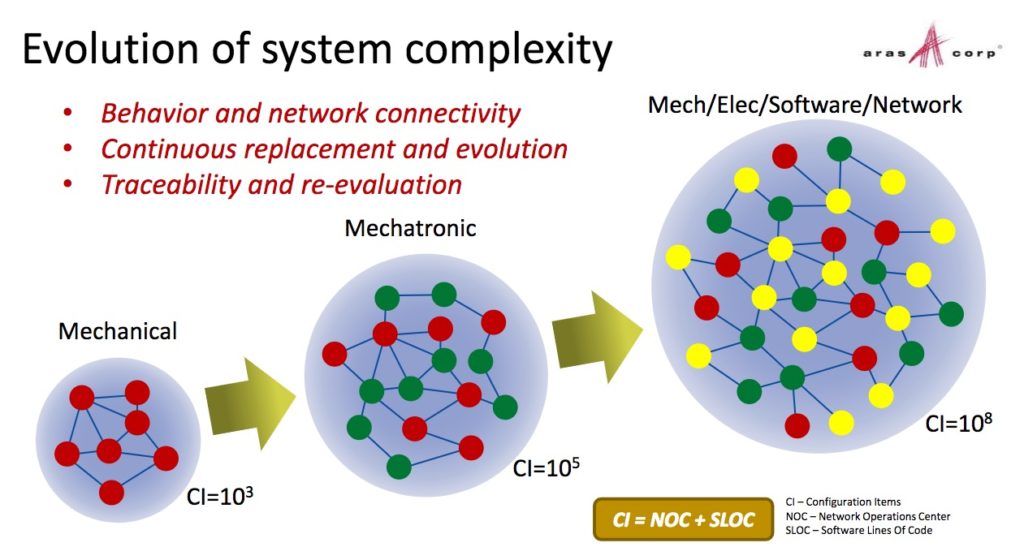
Aras’ presentation by Pawel Chadzynski MBSE and the Business of Engineering brings some interesting perspective of what Aras is thinking about model driven system engineering. I can see a growing interest in model-driven approach, but not much agreement how things supposed to work. In a nutshell, everyone agrees that model is a good thing and if we can apply ‘model’ to serve our needs, then organizations can get lot of benefits from variety of aspects – data traceability, early data exploration, change management and more.
Aras’ slide deck does an excellent job presenting complexity of production development. The visualization of circles and with colored nodes-network is really neat. I like it.

Things are getting a bit more complex when you go into some implementation slides mapping MBSE models with PLM structures. I like the slide.

However, it made me think about few potential complexity challenges (1) change complexity; (2) organization complexity.
1- Change complexity
The static model looks nice and allows you to have full traceability of data. It gives you a tremendous value. However, I was trying to image the change in this structure and things were shaking because of multiple changes that can happen simultaneously in a model of connections, changes, revisions, versions and structures. This is a moment when change model can conflict with collaboration model. The transactions can be dead-locked or apply to old data. I’d was looking for change management diagram, but presentation doesn’t have one.
2- Organization complexity
To apply organizational structure into this model can be even more interesting experiment. PLM and MBSE models are not mentioning organizational boundaries. Once applied, can trigger a question of database boundaries. If an entire structure is managed as a single tenant, it will most probably survive. But then everybody in an entire organization of OEMs, Tier 1…n, contractors and suppliers will be using the same PLM database. The reality might be different and it will introduce another level of complexity in the implementation (organizational silos).
What is my conclusion? I like the model of connecting PLM structures with extended information sets of system engineering domain. However, I’m curious how both change management and organizational complexity can be managed. Although, I can see a value even in a read only structure connecting domains of information. But, the notion of Enterprise ECM assumes some dynamic behavior and the reality of distributed work can demand companies to work in multiple databases or event more complex architecture to support it. How to solve these problems is a topic for another blog. Just my thoughts…
Best, Oleg
Want to learn more about PLM? Check out my new PLM Book website.
Disclaimer: I’m co-founder and CEO of OpenBOM developing cloud based bill of materials and inventory management tool for manufacturing companies, hardware startups and supply chain. My opinion can be unintentionally biased.
The post Achilles Heel of MBSE and PLM modeling appeared first on Beyond PLM (Product Lifecycle Management) Blog.



Be the first to post a comment.